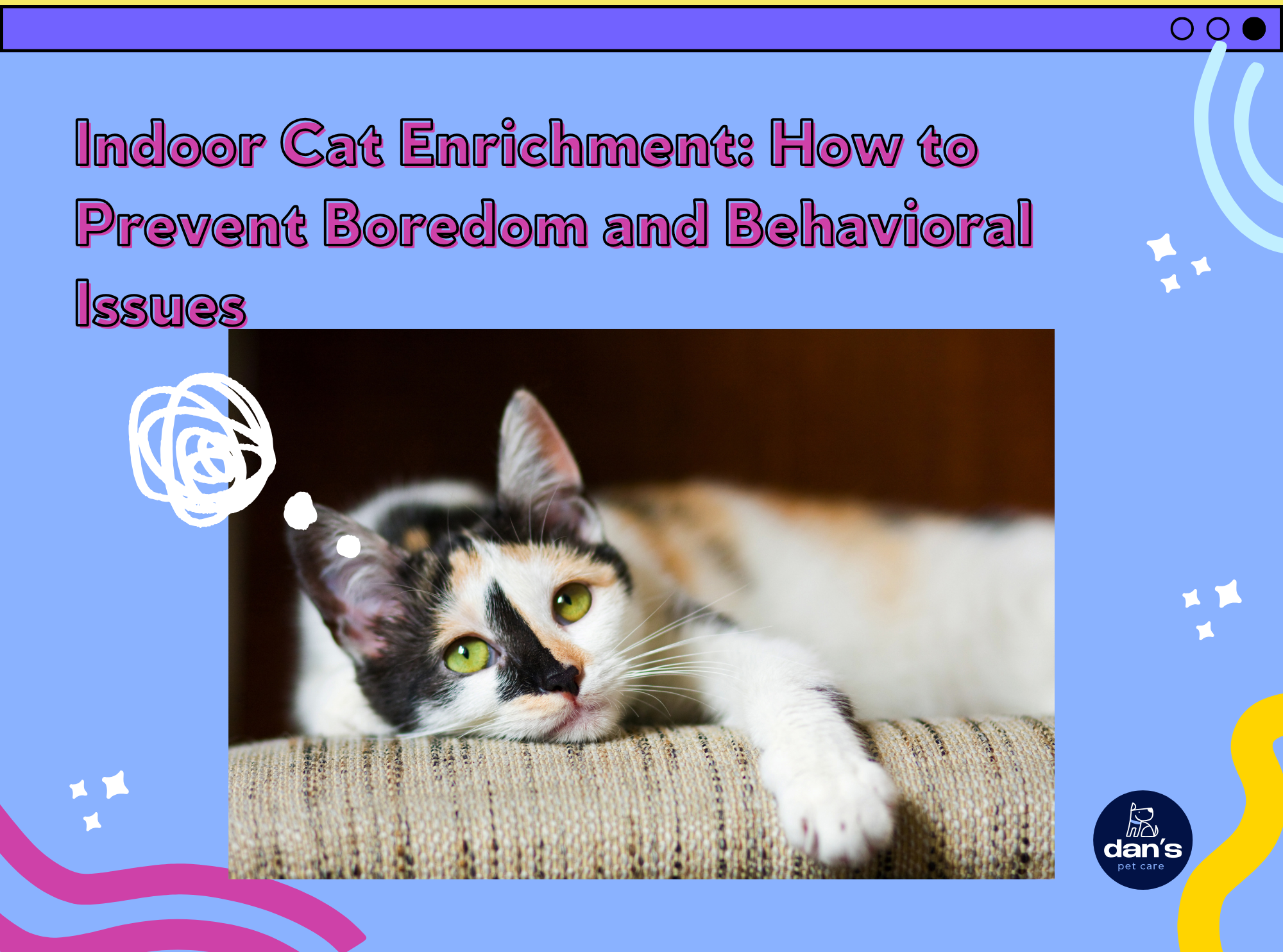Indoor cats are safer from outdoor hazards like traffic, predators, and diseases, but their protected environment can come with a hidden downside—boredom. Without the stimulation that comes from hunting, exploring, and climbing outdoors, cats may develop behavioral issues such as aggression, overgrooming, or depression. Fortunately, with thoughtful indoor cat enrichment, you can keep your feline both mentally and physically stimulated. Whether you're on Long Island or anywhere else, creating a rich indoor environment is essential for a happy, healthy cat. This guide explores practical indoor cat activities, engaging enrichment ideas, and long-term solutions to prevent boredom in indoor cats.
1. Why Enrichment Is Important for Indoor Cats
Cats are natural hunters and explorers. Even if they live indoors, their instincts remain intact. Without opportunities to express these instincts, indoor cats can become restless, frustrated, or anxious. Enrichment provides a way to channel their energy and curiosity productively. It helps improve their overall well-being and reduces the likelihood of destructive behaviors. Cats who are enriched are more confident, interactive, and less prone to obesity and behavioral problems. Boredom can lead to health issues like stress-induced cystitis, compulsive grooming, or overeating. Indoor enrichment doesn’t just keep cats entertained—it supports a long, healthy life by nurturing their minds and bodies every day.
2. Signs Your Cat Is Bored
Recognizing boredom in cats isn’t always easy. Unlike dogs, cats may not openly display restlessness. Instead, their boredom can manifest in subtle or surprising ways. Some common signs include:
Excessive sleeping
Overgrooming or hair loss
Aggression or sudden mood swings
Destructive scratching or chewing
Vocalizing more than usual
Obsessive behaviors like pacing or tail chasing
If your cat displays one or more of these symptoms, it could be time to evaluate their environment. Boredom is not a character flaw but a sign your cat needs more stimulation. Addressing it proactively can prevent more serious health or behavior issues from developing.
3. Rotating Toys and Stimulating Play
Cats thrive on novelty. Leaving the same toys out all the time may cause them to lose interest quickly. Rotate toys weekly to make each one feel new again. Choose a mix of textures, sizes, and movements to stimulate different senses.
Try these toy ideas:
Feather wands and fishing pole toys
Laser pointers for chase play
Crinkle balls and textured mice
Motorized toys that mimic prey
Catnip-infused soft toys
Spend 10 to 15 minutes twice a day actively playing with your cat to reinforce your bond and give them structured activity. Solo play is important too—leave toys that move or crinkle for your cat to discover on their own. Play is a major component of enrichment and keeps cats mentally sharp.
Choose a mix of textures, sizes, and movements to stimulate different senses. Interactive toys like feather wands, laser pointers, and motorized mice are ideal for simulating hunting behaviors. Spend 10 to 15 minutes twice a day actively playing with your cat to reinforce your bond and give them structured activity. Solo play is important too—leave toys that move or crinkle for your cat to discover on their own. Play is a major component of enrichment and keeps cats mentally sharp.
4. Puzzle Feeders and Treat-Dispensing Toys
Popular options to try:
Treat-dispensing balls
Compartmentalized puzzle trays
Slow feeders with built-in mazes
DIY puzzles using egg cartons or paper rolls
Food enrichment is an excellent way to engage your cat’s brain and slow down fast eaters. Puzzle feeders and treat-dispensing toys encourage your cat to work for their food, mimicking natural hunting behavior. There are many types of puzzles, from simple rolling balls with holes to more advanced trays with hidden compartments. You can also make DIY versions with toilet paper rolls or egg cartons. Incorporating food puzzles into daily routines prevents boredom while promoting healthy eating habits. For cats with weight issues, these tools can help reduce calorie intake and increase physical activity. Feeding time becomes more than just a meal—it becomes a game.
5. Cat Trees, Wall Shelves, and Vertical Space
Great vertical enrichment features include:
Multi-level cat trees
Wall-mounted climbing shelves
Window-facing perches
Over-the-door climbing structures
Cats love to climb and perch. Vertical space is just as important as floor space in a cat's environment. A well-placed cat tree can provide exercise, a safe vantage point, and a comfortable nap zone all in one. Wall-mounted shelves or cat bridges allow your cat to explore and patrol their territory from above. This kind of enrichment is especially important in homes with limited space or multiple pets. Cats feel more secure when they can observe their environment from high places. Make sure vertical spaces are sturdy, varied in height, and easily accessible. Position them near windows for added stimulation.
6. Window Perches and Birdwatching Stations
Set up an irresistible birdwatching zone with:
Suction-cup window hammocks
Cushioned window ledges
Outdoor bird feeders near windows
Carpeted shelves for cozy lounging
Setting up a window perch is one of the easiest ways to entertain your indoor cat. Cats are naturally curious, and watching the world go by offers endless enrichment. Consider placing a bird feeder outside the window to create a live-action show. Your cat will enjoy hours of visual stimulation while staying safely indoors. Some cats even vocalize or chirp at birds, showcasing their predatory instincts. Window hammocks, padded ledges, or carpeted shelves can all serve as great viewing spots. Just make sure the window is secure and the perch is stable. This low-effort upgrade can dramatically improve your cat’s daily routine.
7. Sensory Enrichment with Scents and Sounds
Ideas for sensory variety:
Rotate catnip or silvervine toys
Play birdcall or nature audio tracks
Provide new textures like sisal or felt
Introduce soft lighting or cozy bedding
Engaging your cat’s senses is a fun and often overlooked part of enrichment. Scents like catnip, silvervine, valerian root, or even lavender (in moderation) can spark curiosity or induce relaxation. Rotate scent-based toys to keep the effect fresh. You can also introduce new textures, like fleece, sisal, or crinkle paper, for tactile exploration. Sound plays a role too—consider playing nature sounds, bird calls, or soft classical music. Some streaming services even offer playlists designed specifically for cats. Sensory enrichment stimulates your cat’s brain in new ways and adds variety to their environment. It's a simple yet effective way to prevent boredom.
8. Training and Mental Challenges
Easy enrichment games to try:
Clicker training for tricks like sit or high five
Hide-and-seek with treats
DIY cardboard box mazes
Scent trails using a favorite treat
Contrary to popular belief, cats can be trained just like dogs. Teaching your cat simple tricks like sit, high five, or come when called is both mentally enriching and rewarding. Use clicker training and positive reinforcement with high-value treats. Short, consistent sessions are key. Training provides mental exercise and strengthens your bond with your cat. You can also hide treats around the house or create scavenger hunts to encourage foraging. Puzzle toys and scent games offer daily mental challenges that stave off boredom. Training not only helps your cat focus but can also reduce undesirable behaviors by channeling their energy constructively.
9. Social Interaction and Companionship
Cats are often seen as solitary animals, but many enjoy social interaction. Boredom can be reduced simply by spending quality time together. Whether it's lap cuddles, gentle brushing, or interactive play, your attention makes a difference. Some cats benefit from the companionship of another pet, but introductions should be slow and supervised. If you’re away often, consider hiring a pet sitter to provide enrichment and companionship in your absence. Human interaction helps reduce loneliness and strengthens trust. Even brief sessions of undivided attention can enrich your cat’s life and help prevent behavioral issues.
10. Professional Cat Visits for Extra Enrichment
Sometimes your schedule doesn’t allow for as much daily enrichment as you’d like to give. That’s where professional pet care services come in. At Dans Pet Care, we offer dedicated cat visit services across Long Island designed to keep your feline friend happy and active. Our experienced caregivers provide individualized attention, playtime, feeding routines, and companionship—all tailored to your cat’s needs. Whether you're traveling or working long hours, your cat doesn’t have to miss out on stimulation. Learn more about our trusted cat visit services at danspetcare.com/cat-visit-services. We’re here to help your cat thrive in the comfort of their home.
Conclusion: Keep Your Indoor Cat Happy and Healthy
Indoor cat enrichment is not just about toys—it’s about creating a life full of purpose, exploration, and comfort. By combining interactive play, vertical space, food challenges, and social interaction, you can help prevent boredom and behavioral problems. A stimulated cat is a happy cat, and small changes in your home environment can make a big impact. At Dans Pet Care, we’re committed to helping Long Island pet parents provide the best for their cats. Explore our enrichment-focused cat visit services and more at danspetcare.com. Let’s keep your cat purring and thriving every day.





